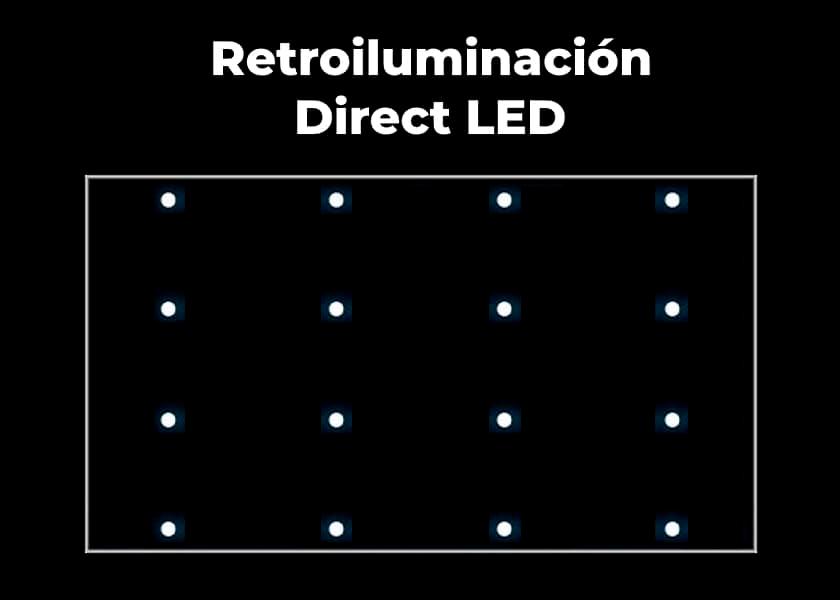There are tons of TVs and monitors on the market equipped with LED panels. It becomes difficult to know which one to choose. There are several doubts that assail our heads when we are faced with a VA or IPS panel in which its backlight is the key. Perhaps you have never stopped to see if the TV you want to buy is Edge LED, Direct LED or Full Array. That is why we are going to explain what differences exist so that your choice is correct.
Televisions with LED technology consist of liquid crystal displays (LCD) along with diffusers, filters, polarizers, etc. which is illuminated by diodes or LED bulbs. Unlike OLED TVs, LED TVs cannot generate their own light and have to rely on a system of LED bulbs. Some of the latest technologies to reach the market are miniLED and microLED, both a great bet for the future in televisions with sizes between 65 and 75 inches in the case of miniLED and in smaller sizes in the case of microLED.
When buying an LED television you will come across terms such as Edge LED, Direct LED or Full Array, whose function is to indicate what the panel lighting is like. There are different ways of backlighting LED panels. Let’s see what their differences are.
What is Edge LED
This is the lighting system used by lower-end LED televisions, being the system that achieves less depth in blacks. It allows to offer thinner designs. The models that have this system usually have a strip of LED bulbs on the lower edge of the screen. A guide plate is used so that the light is projected around the entire screen.
TVs that use this technology are usually cheaper and consume less energy. However, we will suffer a bit when it comes to seeing especially dark scenes, since this system causes that on some occasions a deep black level is not achieved. Other aspects must also be taken into account, such as local dimming, the functionality that regulates lighting by sectors. Depending on how effective the lighting dimming is, the contrast will be better or worse.
Advantages
- slim design
- consume less energy
- cheapest tvs
Disadvantages
- Less precise lighting control
- shallower blacks

Different distribution and number of LED bulbs
What is Direct LED
Of all the lighting systems, this is perhaps the least used by manufacturers, since it does not offer such a high image quality, making televisions tend to be thicker due to the arrangement of LED lighting.
The TVs that use this system have the LED bulbs that illuminate the screen placed on the back. Something similar to what you will be able to find in televisions with a Full Array system (which we will explain later), unlike the fact that the number of LED diodes is much lower, giving rise to less precise lighting. It is common to find it in mid-range and high-end TVs, and the arrangement of the bulbs makes the screen better than Edge LED.
Advantages
- uniform illumination
- cheap price
Disadvantages
- Thicker than Edge LED TVs
- Low contrast as there is no local dimming

DirectLED
What is Full Array Local Dimming (FALD)
We are going to find this lighting system in high-end televisions, since it is by far the best technology before making the leap to OLED panels. Compared to Direct LED, the number of LED bulbs placed at the rear is higher. It increases contrast levels and is the only way for manufacturers to compete with the premium segment of OLED panels.
The fact that the number of LED diodes used is greater allows the lighting of the screen to be better distributed than in the systems mentioned above. In order to control the lighting more precisely, they have a control panel that controls a number of blocks independently. Each block allows you to adjust the lighting to turn on or off specific areas. Aspect that we are going to notice especially in the dark scenes of some movies and series where the black tones are going to be deeper. In addition, the brightness will also be higher than in Edge LED and Direct LED technologies. Light leaks are also reduced and, in short, they are the best option if you are looking for an LED television.

FALD
Advantages
- Superior contrast and brightness
- Reduction of light leaks
- very precise blacks
- Homogeneity on the screen
Disadvantages
- Thicker teles
- highest price
- Highest power consumption
Full Array Local Dimming is by far the best because it offers OLED-like picture quality with true-to-life blacks, high contrast and powerful brightness, plus the LED bulbs turn on and off as needed.












